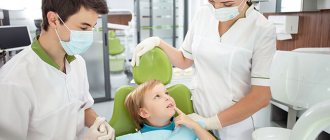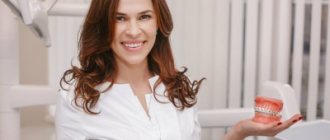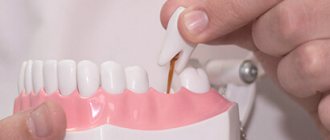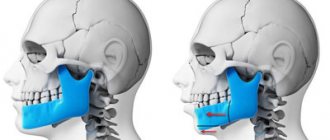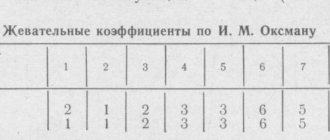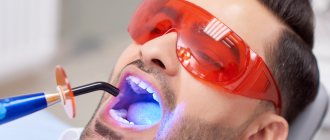Dentist (general dentist)
Job responsibilities.
Provides qualified medical care. Receives information about the disease: applies objective methods of examining the patient; identifies general and specific signs of the disease, especially in cases requiring emergency care; assesses the severity of the patient’s condition; determines the volume and sequence of resuscitation measures (including artificial respiration, cardiac massage, stopping bleeding, dressing and tamponade of the wound, transport immobilization, gastric lavage in case of poisoning, urgent tracheotomy in case of asphyxia) and provides them in case of traumatic and anaphylactic shock, acute vascular collapse, acute blood loss, acute cardiac and respiratory failure, hypertension and other life-threatening conditions. Conducts examination of the dento-maxillofacial apparatus: soft tissues of the face, temporomandibular joint, salivary glands, regional lymphatic system, probing of teeth, pathological periodontal pockets, fistulas; carries out percussion and thermometry of teeth, electrical odontometry, determines the severity of disease of the oral mucosa, as well as factors contributing to the development of periodontal pathology, symptoms of inflammation and destruction of periodontal tissue. Determines the need for special research methods (including laboratory, radiological, radioisotope, functional, interprets their results. Conducts differential diagnosis of major dental diseases in adults and children; substantiates the clinical diagnosis, plan and tactics of patient management in accordance with the standards of medical care for children and adults. Performs local (infiltration and conduction) anesthesia and determines indications for general anesthesia in the treatment of dental diseases. Carries out the prevention of major dental diseases in children and adults; organizes hygienic training and education of children and parents, teachers, paramedical personnel; plans dispensary work. Conducts assessments cariesogenic situation and the hygienic state of the oral cavity using indices. Teaches the rules of oral hygiene. Carry out measures for professional oral hygiene using mechanical and hardware methods, preventive treatment of teeth with anti-caries agents, sealing of fissures, whitening of teeth, removal of soft and pigmented plaque on teeth, application of air - abrasive systems, abrasive pastes, brushes, rubber bands and strips. Carry out the necessary diagnostic, therapeutic and rehabilitation measures for developmental and teething disorders, caries and other diseases of the hard tissues of teeth; with increased abrasion, grinding (abrasive wear), erosion, pathological resorption, hypercementosis, deposits on teeth, discoloration of hard dental tissues, hypersensitivity of dentin and enamel, with diseases of the pulp and periapical tissues, with gingivitis and periodontal diseases, with changes in the gums and edentulous alveolar margin, stomatitis, diseases of the lips and mucous membrane of the mouth, tongue, with complete and partial loss of teeth. Establishes a diagnosis; provides symptomatic therapy; refers to a specialist doctor for treatment if somatic diseases occur in the mouth. Performs filling and restoration of teeth using all types of filling materials; application of rubber dam and its modifications; production of veneers using the direct method from composite materials; treatment of pulpitis, aimed at preserving or removing the pulp, endodontic treatment of pulpitis and periodontitis through mechanical and medicinal treatment of root canals using manual, machine and ultrasonic instruments; obturation of root canals using pastes and gutta-percha. Carrying out diagnostic, therapeutic and rehabilitation measures for inflammatory periodontal diseases, removing supragingival and subgingival tartar (followed by polishing the surface of the teeth) manually and using machines; antimicrobial and anti-inflammatory treatment with the use of topical drugs through application, instillation, application of periodontal dressings, elimination of pain sensitivity on the surface of the roots of teeth using the fluoridation method and the use of films with drugs. Provides diagnosis and treatment for acute and chronic diseases of the oral mucosa due to mechanical, physical and chemical trauma, viral and bacterial infections, allergic reactions. Conducts orthopedic treatment of caries with inlays made by light or temperature polymerization, pulpitis and periodontitis with pin structures made by light or temperature polymerization, inlays, artificial crowns made by casting from base metals, light or temperature polymerization and a combined method. Provides treatment for partial tooth loss with bridges made by light or temperature polymerization, the supporting element of which is an inlay, a pin structure, an artificial crown, partial removable lamellar dentures made by light or temperature polymerization, the fixing elements of which are bent and cast metal clasps made of base material metal Provides treatment for complete loss of teeth with complete removable dentures, repair and correction of removable laminar dentures, treatment for periodontal diseases with temporary removable, splinting dentures, plastic mouth guards made by polymerization. Conducts diagnostic, therapeutic, rehabilitation and preventive measures for inflammatory diseases of the maxillofacial region and oral cavity of odontogenic and non-odontogenic origin, provides emergency care for acute toothache; acute purulent inflammatory diseases; carries out surgical treatment of acute periostitis of the jaws, removal of roots and teeth (except impacted and dystopic), treatment of alveolitis, pericoronitis, stopping alveolar bleeding, suturing the wound, drainage and medicinal treatment of purulent wounds, dressing after surgical interventions. Provides treatment for dental trauma, for jaw fractures - production and application of wire splints, reduction of dislocation of the temporomandibular joint, application of temporary transport immobilization. In accordance with the approved routing scheme, when identifying (suspicious) signs of cancer, he refers patients to the primary oncology office (department), promptly refers patients with cancer to a specialized oncology medical organization, and monitors patients at risk.
Dental Treatment Options
- Fillings. The doctor restores the voids formed after cleansing using filling materials. In his practice, he uses amalgam, porcelain, gold or rubber-based composite material. Each substance has its own advantages and disadvantages. Before installing a filling, the doctor discusses this information with the patient in order to determine what to choose.
- Treatment of dental canals. In this case, the damaged pulp is removed, and the tooth itself is filled with an antibacterial filling, after which it is isolated from external factors by covering it with a crown.
- Bonding. The essence of this cosmetic procedure is to apply a composite to the front or back of the tooth in order to restore it. This way you can improve its appearance, give it a healthy color, lighten stains, hide chips and uneven surfaces.
- Orthodontics. Long-term treatment of crooked teeth using retainers and braces to give your smile an aesthetic appearance.
Dentistry unified qualification directory
Modern equipment, instruments and materials used in dentistry. 1.5.5. Actions of personnel upon detection of a patient with signs of particularly dangerous infections, AIDS. 1.5.6.
Rules and regulations of occupational health, safety, industrial sanitation and fire protection. 1.6. During the period of temporary absence of the Employee, his duties are assigned to.
II. JOB RESPONSIBILITIES 2.1. Employee: 2.1.1. Carry out diagnostics, provide therapeutic and emergency care for diseases and lesions of the teeth, oral cavity and maxillofacial area. 2.1.2.
Job description
Provides orthopedic treatment of defects and deformations of the maxillofacial area. Conducts orthopedic treatment of pathology of the temporomandibular joint.
Evaluates the quality of dentures manufactured by a dental technician. Carries out rehabilitation measures after the application of dentures and conducts clinical observation.
Provides education to patients regarding proper oral hygiene. Prepares accounting and reporting documentation approved for use in the Russian Federation. Determines the amount of necessary first and emergency aid and provides it. Identifies indications for urgent or planned hospitalization. Identifies possible complications of drug therapy.
Specifics of the use of general anesthesia in dentistry when using anesthesia
It is important to know that treatment and removal of teeth under general anesthesia can only be carried out in dentistry that meets the following criteria:
- availability of a license to use such methods;
- the presence of an anesthesiologist on staff who must monitor the patient’s condition during the procedure;
- the presence of special equipment in the form of an anesthetic delivery system (for inhalation anesthesia), equipment for monitoring the patient’s condition according to parameters such as heart rate, pulse, blood pressure, X-ray machine;
- sufficient experience of the dentist and all staff in this field.
Indications for the use of general anesthesia
Dental treatment under general anesthesia is justified in the following situations:
- The presence of mental illnesses that preclude the patient from adequately perceiving the situation, his persistent reluctance to perform dental procedures, and the presence of dental problems. These patients may not be able to fully control themselves, and the presence of sharp rotating instruments in the mouth can cause significant injury. In addition, conventional anesthetics in this case lead to an excessive increase in adrenaline in the blood, which contributes to the deterioration of the general condition of the underlying mental illness.
- The presence of an increased gag reflex, when vomiting is caused by touching the soft palate or even other parts of the mucous membrane.
- Allergic reaction to local anesthetics used.
- The presence of mental or neurological disorders that make it impossible to adequately respond to a doctor’s request.
When considering the possibility of treatment and tooth extraction under general anesthesia , we must not forget about the fairly high risk associated with the use of this method of general anesthesia.
- To avoid serious complications, the use of general anesthesia is contraindicated:
- pathology of the cardiovascular or respiratory system;
- presence of high blood pressure;
- pregnancy.
Under general anesthesia in Samara. Tooth extraction under general anesthesia. Dental treatment under general anesthesia. Treat all teeth under general dental anesthesia or local anesthesia. General anesthesia teeth or dental treatment under general anesthesia
Benefits of general anesthesia (full general anesthesia)
Undeniable advantages of general anesthesia:
- Possibility of changing the depth of anesthesia until the patient is in a deep state of sleep;
- Strict dosage of incoming medications and the ability to control the state of loss of sensitivity;
- Fast and comfortable treatment of children and patients with many dental problems;
- Possibility of simultaneous treatment or removal of up to ten teeth due to the long-term effect of anesthesia;
- Painless and effective osteoplastic, maxillofacial surgery, dental implantation, prosthetics of missing teeth;
- Removal of wisdom teeth if the process is complicated by an atypical arrangement of teeth.
Tooth extraction under general anesthesia, teeth under general anesthesia price tooth under general anesthesia, teeth for a child under general anesthesia, teeth treated under general anesthesia, general intravenous anesthesia tooth extraction price
Dental forum
I approve [position, signature, full name of the manager or other official authorized to approve the job description] [date, month, year] M.P. Job description of a dental therapist [name of organization, enterprise, etc.
p.] This job description has been developed and approved in accordance with the provisions of the Labor Code of the Russian Federation, Decree of the Government of the Russian Federation of February 14, 2003 N 101 “On the working hours of medical workers depending on their position and (or) specialty”, resolution State Labor Committee of the USSR and the Presidium of the All-Union Central Council of Trade Unions dated October 25, 1974 N 298/P-22 “On approval of the list of industries, workshops, professions and positions with hazardous working conditions, work in which gives the right to additional leave and a shortened working day” and other normative legal acts regulating labor relations. 1.
Disadvantages of general anesthesia (full general anesthesia)
- There may be a possible presence of individual sensitivity to drugs with the effect of reduced or increased sensitivity or long-term aftereffects from anesthesia with deterioration of health (drowsiness, confusion, dizziness, vomiting);
- The need to carry out additional preparatory measures in the form of a general examination , obtaining an ECG 5 hours before the anesthesia procedure is to be performed, avoiding eating three hours before visiting the dentist, and should not consume alcoholic beverages.
- The high speed of work of a dentist in the oral cavity and the associated increased radicalism during manipulations. The doctor’s work time is limited; it is necessary to do all the planned manipulations in the oral cavity; there is not always time for a painstaking search for canals in the roots of the teeth or treatment of teeth in the stage of moderate caries.
- Death of a patient as a result of unexpected general reactions to the administered drug
- To avoid complications of the patient, before performing dental treatment using general anesthesia, it is advisable to examine it in as much detail as possible, especially if you plan to give anesthesia to a child. There is no doubt that these examinations, firstly, sharply reduce the number of patients for whom anesthesia is indicated. After all, if you approach the examination results strictly, many patients will have to be excluded. Secondly, this will lengthen the process of dental treatment; many examination results will have to wait several days from the laboratory. And thirdly, this will further increase the price of the total cost of treatment, which is already quite considerable.
- Such a strict approach is primarily opposed by the patients themselves; few people want to undergo a lot of tests for several days at their own expense; people choose general anesthesia for the sake of speed, in order to cure all their teeth at once.
- However, if unforeseen complications arise, all doctors and patients turn into strict judges and ask with surprise why a detailed examination was not carried out. The truth is that miracles do not happen and any medical intervention has its risks.
- The high cost of general anesthesia is several times higher than the cost of local methods of pain relief due to the need for additional equipment in the clinic and the need to attract an additional anesthesiologist.
- An accompanying person is required to assist a patient after a dental appointment.
Tooth extraction under general anesthesia price, Samara, dental treatment under general anesthesia. Prices for dental treatment under general anesthesia in Samara - price of wisdom teeth removed under general anesthesia where, is it possible to remove teeth under general anesthesia
Immersion of the patient in a state of sleep for 60 minutes allows the following types of work to be performed
- removal of 4-10 teeth (the number depends on the complexity of the procedure);
- removal of 2-4 teeth, characterized by difficult eruption (impacted teeth);
- treatment of 3-5 teeth at the stage of pulpitis (the number is determined by the condition of the roots and canals of the teeth);
- treatment of carious formations up to 5-8;
- installation of dental implants in the required quantity with osteoplasty and sinus lift;
- treatment of periodontitis for up to 3 teeth, depending on the complexity and curvature of the tooth canals.
Teeth under #general anesthesia Samara, wisdom teeth under general anesthesia, #teeth extraction under general anesthesia reviews prices, where to remove teeth under general anesthesia.
Two types of general anesthesia
- Intravenous - injection anesthesia
Today's preference for this option is given by the maximum number of doctors. Special medications that are administered over a specific period of time (the dose is determined by the anesthesiologist).
This method requires appropriate knowledge and experience and can only be performed by a specialist anesthesiologist.
Among the most commonly used drugs are Gekennal, Sombrevin, Calipsool. The patient's condition during the treatment procedure is monitored by an anesthesiologist.
- Inhalation anesthesia
For this type of anesthesia, a special mask is used, through which an anesthetic composition is supplied in a gaseous state - a mixture of gas and oxygen, which enters directly into the respiratory tract, quickly being absorbed into the blood. Nitric oxide, fluorotane, is used as the main anesthetic drug.
Also, during inhalation anesthesia, an intubation tube is used to deliver a general anesthetic.
It is difficult to act as an independent expert in a field of medicine in which you do not practice regularly. However, long experience in surgical dentistry has made it possible to use immersion of patients into medicinal sleep at the reception. At one time, the appointment was carried out at a hospital with the assistance of an anesthesiologist, so it was possible to observe in practice all the features of general anesthesia in dentistry.
First of all, it is necessary to distinguish between premedication drugs and anesthetic drugs. If the first ones can be purchased using a simple recipe. the latter are difficult to acquire, and most importantly, it is difficult to account for their use. The medical institution has many problems with taking them into account; many have seen reports in the press about criminal cases filed against dentists or veterinarians. What should a poor operational worker do if, when checking, he sees that according to the magazine there should be three ampoules of the drug in stock, but there are only two available. In fact, one ampoule went somewhere else, and this is a criminal offense.
Therefore, dentists often use a complex drug mixture for premedication instead of a single drug for general anesthesia. These combinations are officially prescribed in textbooks, they may well be an alternative to general anesthesia, they give almost the same effect. This form of premedication is an excellent solution for a dental appointment, except for two disadvantages.
- Complex combinations of drugs are difficult to control and produce pronounced aftereffects. Most often, they have a strong inhibitory effect and can depress breathing and cardiac activity. Combinations may contain atropine, which is very undesirable.
- The presence in the pharmacopoeia of excellent drugs for raush anesthesia, recommended specifically for short-term outpatient interventions in dentistry, otorhinolaryngology, and gynecology.
An example is midazolam. The drug is little known in Samara, there is almost no experience with its use. Belongs to the group of benzodiazepines, close to tazepam, seduxen. Ultra-fast and ultra-short-acting drug. Provides an excellent level of general immersion with the removal of fear and pain; the patient experiences a superficial pink sleep, allowing the dentist to carry out any intervention slowly and with high quality.
But the main advantage of this drug is that the sleep itself is very superficial, contact with the patient is maintained, the person answers questions, can control his condition and gives signals when it changes, but still sleeps. After completing the treatment, the doctor simply says, “The treatment is over, let’s get up,” and the patient wakes up with a smile. A cup of coffee finally drives away the aftereffect of the drug.
The drug midazolam can be used in tablets and solution; there is no need for intravenous injection. In tablets, the effect occurs within the usual 20 minutes. The uniqueness of the drug is that it can be used intranasally in solution, then the total dose is significantly reduced, and the onset of sleep is sharply accelerated.
But, obviously, today this group of drugs is under very strict control. We do not use strictly controlled drugs, because we are not a hospital and do not have an anesthesiologist on staff.
However, we have a solution for patients with increased fear of visiting the dentist. Oddly enough, you can buy the most powerful sedative drug Novopassit over the counter in a pharmacy. Like any product of the Western pharmaceutical world, it is very widely advertised, freely sold in pharmacies and positioned as a herbal, harmless sedative for daily use. You can take it while driving and give it to children. May be. But it contains the anxiolytic guaifenesin, a very tricky drug. Even 5 years ago, in the instructions for Novopassit (solution) it was clearly called an anxiolytic, and today it is positioned as an expectorant, one of the effects of which is a sedative effect. Thus, it was carefully removed from the list of psychotropic substances and transferred to an expectorant. The calming effect of Novopassit is very strong and is clearly associated not with hop cones and valerian, but with 200 milligrams of guaifenesin in each tablet. By the way, this is a very large dosage for psychotropic substances.
Two such different screenshots.
When taking 2 tablets of Novopassit (as recommended in the instructions) before an appointment with a doctor, the patient receives such a portion of soothing, highly active substances that he laughs merrily in the chair, wondering what funny instruments these dentists have. With a broad gesture, the manufacturer allows you to take 2 tablets 3 times a day, so you can take 2 tablets in advance in the morning so that you are not afraid for sure. The effect of all drugs is very dose dependent.
Good old Corvalol. Many people perceive it as a harmless sedative with a weak effect or as a heart drug for pensioners. In fact, it is a powerful combined sedative that behaves very differently depending on the dose. When taking 10 drops, vasodilating and expectorant properties appear due to the volatility of the valerian and alcohol esters included in its composition. But already after taking 50 drops (recommended in the instructions), the effect of phenobarbital appears, and this is a very strong basic benzodiazepine with a strong sedative effect. The alcohol and valerian ester contained in Corvalol significantly potentiate the effect of the drug. Without violating the instructions, if prescribed by a doctor, you can take 50 drops an hour before your appointment with the dentist and another 50 drops in the dentist’s office; the effect will be quite sufficient to remove the fear of dental treatment. You are strictly forbidden to drive a car; it is advisable to be accompanied by an accompanying person at the reception.
But practice shows that people are not satisfied with simply getting rid of fear and pain. Many people say something like the following - I know that I won’t be hurt or scared at the appointment. I'm scared now when I imagine how scared I will be later. Therefore, I want to know that this “later” will not happen, that I will sleep during the appointment under anesthesia. But this is probably for psychotherapists. As a form of reassurance, I can say that when a patient sees a syringe or a mask for general anesthesia, he immediately remembers all the complications and all the risks, in his eyes there is a frantic horror in front of the darkness of sleep and he is fully aware of the artificiality of his fear of the drill.
Wisdom tooth removal under general anesthesia, wisdom tooth removal under general anesthesia Samara, dental treatment reviews, where teeth are treated under general anesthesia.
Dental treatment.
Are teeth removed under general anesthesia in Samara, can a tooth be treated under general anesthesia, general anesthesia when treating a tooth
Job description of a dental therapist
To occupy the position of a dental surgeon, you must additionally complete a residency in the specialty “Surgical Dentistry” or have professional retraining in the specialty “Surgical Dentistry” and an appropriate certificate. At the same time, we note that according to Order of the Ministry of Health and Social Development of the Russian Federation dated July 23, 2010 N 541n, persons who do not have the appropriate additional professional education or work experience established by the qualification requirements, but have sufficient practical experience and perform high-quality and fully the job duties assigned to them, according to recommendations of the certification commission of a medical organization, as an exception, can be appointed to the appropriate positions as well as persons with special training and the necessary work experience.
Future profession
It is clear that a dentist deals with diseases of the oral cavity. This includes pathologies of teeth and periodontal tissues. After graduating from the specialty 08/31/72 general dentistry (residency), the doctor can not only fill or extract teeth, but also eliminate more complex problems. The competence of this specialist includes the treatment of caries, pulpitis, periodontitis, installation of fillings and restoration of teeth (installation of bridges and crowns).
In some cases, a specialist will have to obtain additional education in order to master a narrower profession (surgery, orthodontics, periodontology).
What positions can a general dentist hold?
A dentist must be prepared for independent professional activity and perform basic functions: organizational, diagnostic, advisory, therapeutic and preventive. He must combine deep theoretical training with practical skills, treat the assigned work responsibly, be demanding of himself and his subordinates, constantly improve his professional competence and level of general culture, engaging in continuous self-education. A dentist is obliged to apply in practice the principles of scientific organization of work, actively use electronic computing and medical diagnostic equipment in relation to the profile of their activities, be able to navigate modern scientific and technical information, effectively use it to solve practical problems, show initiative, integrity and conscientiousness in work.2.
Job Description of a Dentist Specialist
Carry out the necessary diagnostic, therapeutic and rehabilitation measures for developmental and teething disorders, caries and other diseases of the hard tissues of teeth; with increased abrasion, grinding (abrasive wear), erosion, pathological resorption, hypercementosis, deposits on teeth, discoloration of hard dental tissues, hypersensitivity of dentin and enamel, with diseases of the pulp and periapical tissues, with gingivitis and periodontal diseases, with changes in the gums and edentulous alveolar margin, stomatitis, diseases of the lips and mucous membrane of the mouth, tongue, with complete and partial loss of teeth. Establishes a diagnosis; provides symptomatic therapy; refers to a specialist doctor for treatment if somatic diseases occur in the mouth.
Is it possible to treat teeth without a drill?
Sociological surveys show: almost 80% of people are afraid to visit the dentist due to fear of having their teeth drilled. Not only children, but also adults are afraid of drills. If you are also afraid of the need to drill a tooth for its quality treatment, then it will be useful for you to know the following fact: if you seek dental care in a timely manner during dental treatment, you can completely do without a drill!
Fluoridation
If the examination reveals caries in the stain stage, then dental treatment may involve procedures aimed at remineralizing and strengthening the enamel. Tooth surfaces are covered with special gels containing high concentrations of fluoride and calcium and, of course, this treatment is absolutely painless!
Laser treatment
Another option for dental treatment without drilling is the use of laser radiation with a wavelength of a certain length. The laser beam heats and destroys tissues destroyed by caries, and after treatment it will be enough to rinse the area of manipulation with water. The innovative method of dental treatment has many advantages, including: high efficiency of the method; low risks of complications; additional antibacterial effect. The disadvantages include the fairly high price of laser dental treatment and a wide range of contraindications. It is also worth knowing that dental treatment with laser radiation will be painless only when caries has destroyed only the tooth enamel. If the destruction has reached the deep layers of dentin and pulp, before laser dental treatment, the patient is given anesthesia to eliminate unpleasant painful sensations.
Infiltration treatment method
Dental treatment is carried out using Icon technology, which consists of treating carious cavities with a special polymer composition. The active substances in the composition uncouple and dissolve damaged tissue, the remains of which the doctor removes with an alcohol solution. Then the treated areas of the tooth are dried and treated with a polymer resin that fills micropores in the natural enamel coating of the tooth. The tooth treatment using Icon technology ends with the use of a polymerization lamp, which dries the applied composition. The advantages of this dental technique include: maintaining the integrity of the natural enamel coating for a long time, increasing the strength of tooth enamel; the ability to choose a polymer shade that exactly matches the tone of natural enamel; speed of dental treatment - the entire treatment process takes no more than half an hour; The treatment is painless and does not involve the risk of overheating of the tooth tissue.
Icon dental treatment technology is optimal for treating carious stains in the interdental spaces and is suitable for eliminating caries in children.
Ozone therapy
Another method of treating teeth without drilling is ozone therapy, which involves exposing carious cavities to ozone. The impact is carried out by a special device that converts oxygen into ozone. This gas destroys pathogenic microflora and carious bacteria. After treatment with ozone, the tooth is covered with a special gel and the treatment process ends.
Ozone therapy can be used not only to treat teeth damaged by caries. It is indicated for inflammation of the soft tissues of the oral cavity, inflammatory processes in the dental canals.
Job description of a dentist
Performs local (infiltration and conduction) anesthesia and determines indications for general anesthesia in the treatment of dental diseases. Provides prevention of major dental diseases in children and adults; organizes hygienic training and education of children and parents, teachers, nursing staff; plans dispensary work. Conducts an assessment of the cariogenic situation and the hygienic state of the oral cavity using indices.
Teaches the rules of oral hygiene. Carries out measures for professional oral hygiene using mechanical and hardware methods, preventive treatment of teeth with anti-caries agents, fissure sealing, teeth whitening, removal of soft and pigmented plaque on teeth, the use of air abrasive systems, abrasive pastes, brushes, rubber bands and strips.
Benefits of postgraduate study
After passing the exams, the specialist can enter graduate school. The advantages of this are:
- the graduate student continues to improve his skills and study new ways of diagnosing, treating and preventing dental diseases;
- a specialist writes scientific papers and articles;
- a graduate student receives a higher salary than a doctor without graduate school;
- the doctor publishes in scientific journals, attends conferences, and conducts his own research.
Thus, graduate school is suitable for those who are interested in research work.
Which document outlines the job responsibilities of a general dentist?
Performs a list of works and services for the prevention and treatment of dental diseases in children in accordance with the standard of medical care for malformations of hard dental tissues, dental caries, pulp, periodontal, periodontal diseases, as well as diseases of the oral mucosa and lips, including conditions of general anesthesia and sedation with preserved consciousness. Conducts the necessary diagnostic, therapeutic, rehabilitation and preventive procedures and measures for inflammatory diseases of the dentofacial apparatus and oral cavity of odontogenic and non-odontogenic origin: surgical treatment of dental periodontitis, acute periostitis of the jaws; removal of roots and teeth; treatment of alveolitis, pericoronitis, stopping alveolar bleeding; suturing the wound; primary surgical treatment of wounds of the oral mucosa.
What does the dentist do during the appointment?
A general dentist can do both preventive examinations and carry out therapeutic measures. The patient is seated in a special chair, and with the help of a mirror and other instruments, an initial examination is carried out under a lighting lamp.
The doctor taps the tooth, checks the reaction to heat and cold. A mandatory diagnostic method in many cases is x-ray. If treatment is required, the doctor uses a drill.
It is worth noting that at the initial stage, when the disease is not advanced, the procedure for removing caries is not painful—slight discomfort is felt. If the patient comes to the appointment with acute pain, most likely, the doctor will offer him local anesthesia, since in such situations the pulp - the neurovascular bundle - is usually inflamed.
In modern clinics, laser treatment is increasingly used as an alternative to a drill. This type of therapy session takes more time, but it is almost painless and safe.
Job description for a general dentist
HIV infections; - resuscitation techniques; — basics of asepsis and antiseptics; — methods of sterilization of instruments; — first aid methods for bleeding, collapse, anaphylactic shock; — basics of epidemiology; — basics of valeology and sanology; — medical ethics and deontology; — psychology of professional communication; — basics of clinical examination; — basics of disaster medicine; — the procedure for maintaining primary accounting and reporting documentation, including in electronic form; — basics of labor legislation; — labor protection and fire safety rules. 2. Job responsibilities of a dental therapist: 2.1.
Performs initial patient visits. Determines the tactics of patient management in accordance with established rules and standards. 2.2.
Job responsibilities of a general dentist
III. RIGHTS 3.1. The employee has the right to: - providing him with work stipulated by the employment contract; — a workplace that complies with state regulatory requirements for labor protection and the conditions provided for by the collective agreement; — complete reliable information about working conditions and labor protection requirements in the workplace; — professional training, retraining and advanced training in the manner established by the Labor Code of the Russian Federation and other federal laws; — obtaining materials and documents related to its activities, familiarizing itself with draft decisions of the organization’s management relating to its activities; — interaction with other departments of the Employer to resolve operational issues of their professional activities; — submit proposals on issues of their activities for consideration by their immediate supervisor. IV.
Sep 10, 2019adminlawsexp
vote
Article rating

